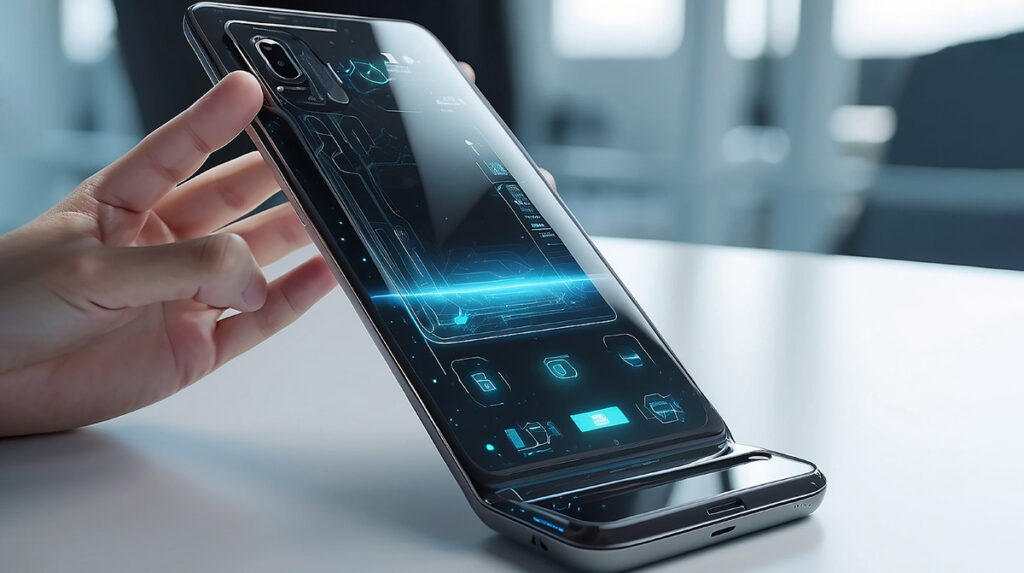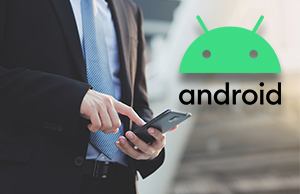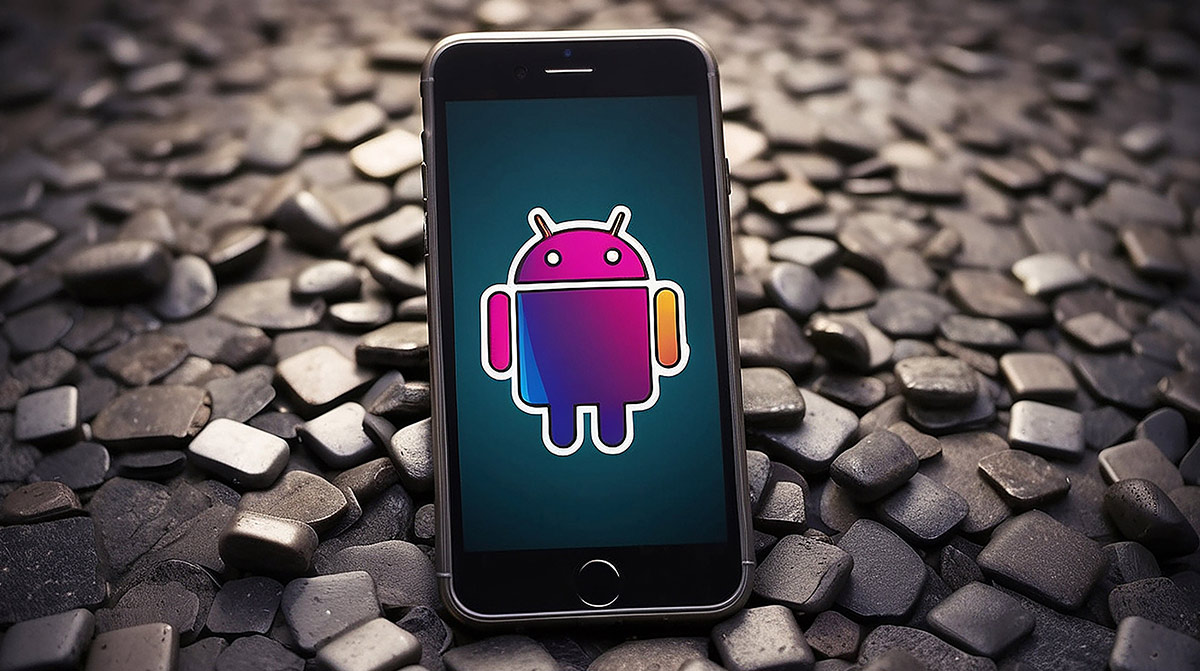Ever since the release of the first iPhone in 2007 and the launch of the first Android shortly after in 2008, the world hasn’t been the same. Smartphones have become a common standard of mobile phones, something that connects all cultures around the world.
In the last ten years, the popularity and technological advancements of smartphones have skyrocketed, offering a multitude of possibilities within their compact form. Moreover, these devices have become hubs of innovation, constantly evolving with enhanced features and fresh designs for Android app development. Android app development has become an essential aspect of this technological landscape.

Manufacturers have tried to introduce their changes to shape consumers’ views on what modern smartphones should have. These changes include the transition from wired to wireless charging, adding a notch to the screen, and the controversial removal of the headphone jack.
The Era Of Foldable Phones
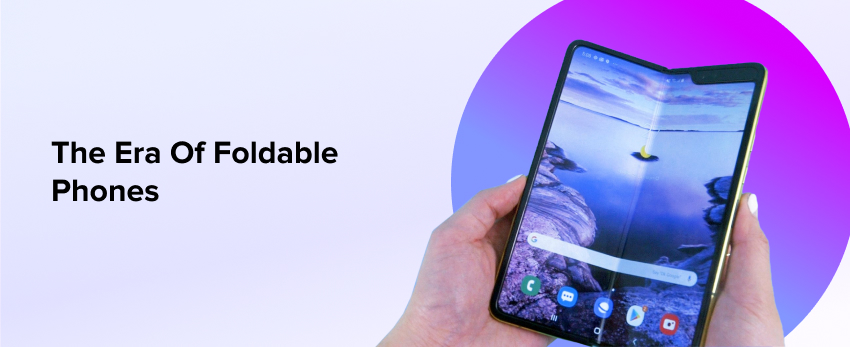
In the realm of technological progress, the conventional trajectory typically involves hardware becoming more robust and powerful. However, smartphones have taken a different route, embracing a contrasting approach. Android, in particular, has been at the forefront of this evolution by introducing larger phones, often referred to as phablets, for its user base.
This shift towards larger phones signifies aspect of digital transformation in the mobile industry.
However, since users faced a lash back with the convenience aspect of these devices, we came across the foldable smartphone technology. Currently, the market has over seven foldable phones, all of which fold in different styles, indicating developers’ take on their devices.
Understanding Foldable Devices
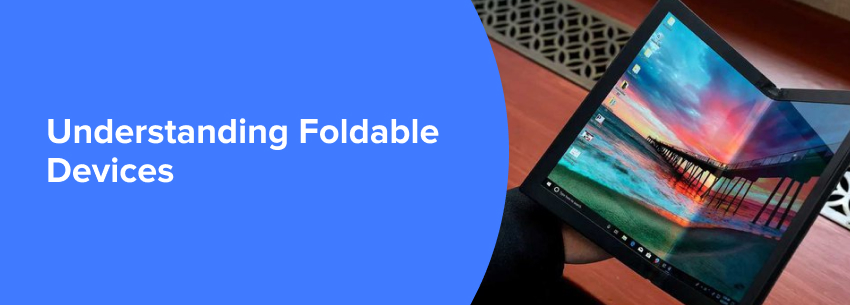
To give you a quick insight, foldable phones are a type of smartphone with a case and a screen that can either roll up or fold (in a specific pattern). Then, when unfolding the smartphone, the screen expands, giving users a larger space with more function.
As mentioned, the market is flooded with different types of foldable technology, all operating under different brands with unique screen ratios. Thanks to the innovation in foldable technology, we have varying aspect ratios to support different types of folds (square or rectangular).
Here’s an overview of the different ratios present currently in the market:
The image above shows that the market is flooded with many anticipated screen ratios. You can find these screen designs used in different brands, namely:
- Samsung Galaxy Z Fold 4
- Microsoft Surface Duo
- Xiaomi Mi MIX Fold
- Samsung Galaxy Z Flip 4
- Huawei P50 Pocket
- Vivo X Fold Plus
- Samsung Galaxy Z Fold 3 5G
- Oppo Find N2 Flip
- Moto Razr 5G
These devices use different aspect ratios to determine their folding abilities. Moreover, the aspect ratios of these screens determine how the device will fold, also dominating its Android app design.
What Does Foldable Device Means To Developers?
A foldable device means more space for users, giving them more screen area to multiply their input. On the contrary, however, increased space means more challenges to develop Android apps.
Wonder how?

The answer is simple: applications must extend to a larger screen, stretching the screen size for improved usability.
Let’s explore more about these challenges in the following section of our blog.
Challenges Of Developing Android Apps For Foldable Devices

The primary idea behind foldable devices is to extend the screen’s usage. The combined screen allows developers to access a larger space, creating a more immersive user experience.
However, the true challenge here is to develop mobile applications. Unlike traditional mobile apps where developers can prepare applications normally, the UX in case of large-screen requires a glitch-free experience that can maximize and minimize as per the screens.
Since the display technology used in Android foldable devices differs, the app design, UI, and UX are also different. Currently, apps for foldable devices face the following challenges:
- Applications that smoothly switch between folded and unfolded modes
- screens with various orientations
- The application’s form factor is different from conventional
- We need to conduct more app testing in various situations.
- Foldable cell phones come in a range of screen sizes.
- Smartphone manufacturers offer a variety of folding smartphone designs and circumstances.
- Longer software development cycles and greater costs
So now that we have an overview of the primary challenges let’s understand more about them in depth.
Challenge 1: Screen Continuity
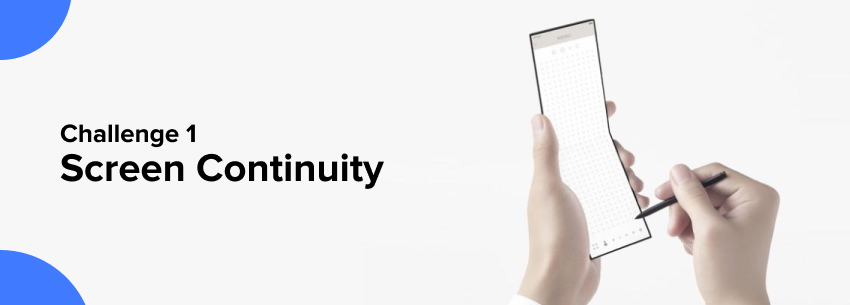
Developers must ensure screen continuity in their applications as Android foldable devices require constant switching between unfolded and folded states. They must create a seamless user experience that continues across the screen, and the resolution expands with the layout changes.
Here, app developers’ challenge is creating ambiguity, which will increase with the screen transition. Therefore, they must create a code that minimizes or nullifies the changes happening in the application design. Besides, since the multi-window pushes the need for multitasking, developers should be wary about such features and incorporate matching design elements.
Challenge 2: Multi-Resume Support
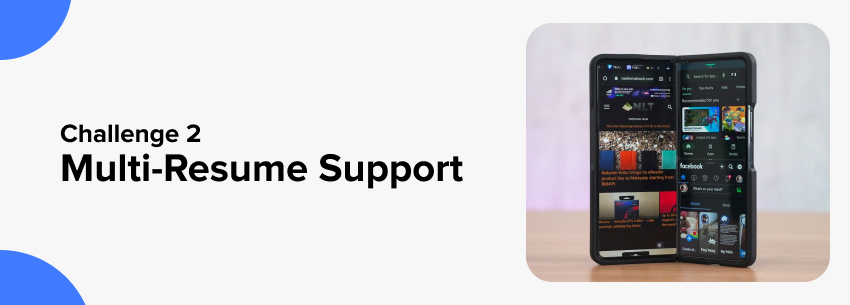
Similar to the multi-tasking aspect of the application, developers need to ensure that their products support multi-resume features. This functionality allows the applications to resume functioning between unfolded and foldable screens without freezing other applications running in the background. Thanks to the Android 10 update, developers can now develop Android apps with multiple functionality.
This update by Google allows users to open different applications besides Android 10. In the past, fold phones could only resume one application after changing the device’s orientation. Therefore, developers must keep the multi-resume functionality in mind while creating their applications to ensure a seamless user experience across different screen sizes.
Challenge 3: Multi-Window Mode
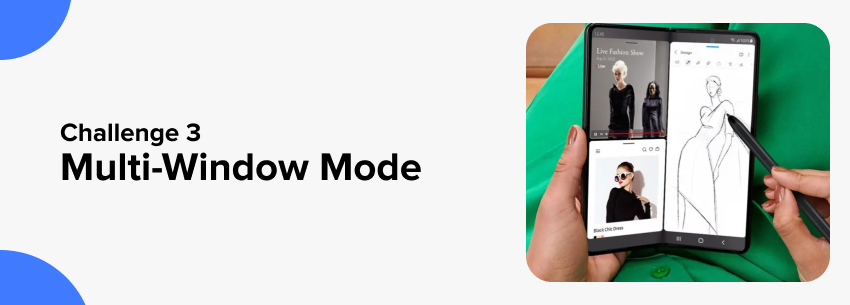
Every foldable device will have two states at any point: Folded and Unfolded.
When kept unfolded, a smartphone transforms into a tablet. This provides an extra screen space to give users an immersive visual and user experience. Here, developers can include more context for including secondary events or actions in their apps. On the contrary, the folded device will function as a traditional smartphone.
The application will need a UI design that enables one-handed operation. The seamless switch between one and two-handed operation demands the efforts of the design teams to look at the critical UI/UX facets. The team needs to be aware of the Android developer options as they would be required to maintain elements within the thumb’s range for the folded device, whereas, in its unfolded state, the screen should have UI/UX elements within the finger’s reach.
Challenge 4: App Continuity
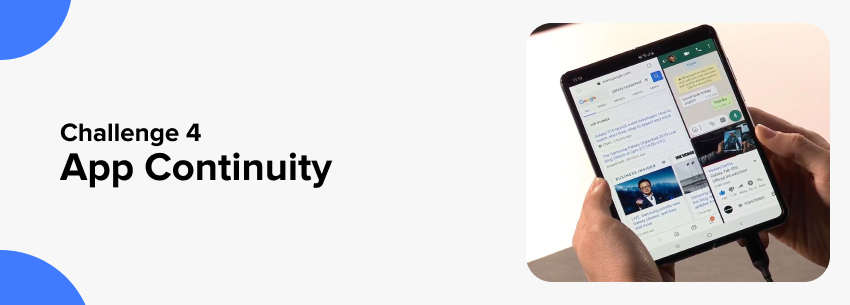
With foldable devices, users can access more screen resolution than traditional straight-screen devices. Thanks to the Android 10 update, the later updates support a wide range of aspect ratios. Android foldable devices can now go from thin and long screens to a 1:1 ratio.
Therefore, the developed applications for these devices must be tested across different resolution formats. In such cases, users must define the minAspectRatio and maxAspect Ratio variables in their code to indicate the minimum and maximum resolution the application can extend or minimize.
Impact Of Foldable Devices On Android App Development
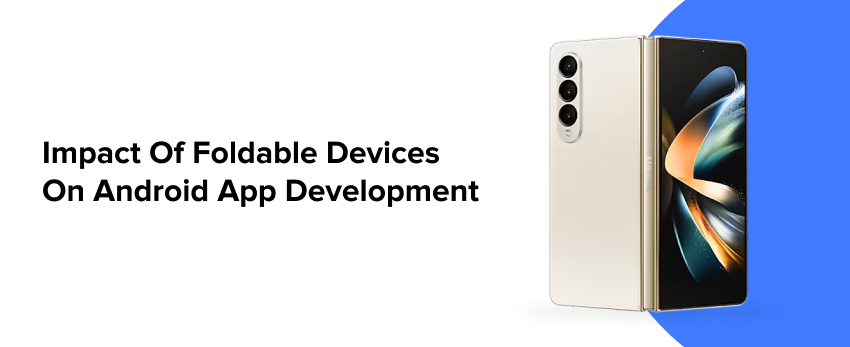
It’s a clear game-changer that foldable phones are becoming increasingly popular. To create apps operating on various screen sizes, developers must research how consumers use their phones.
The design should only undergo minor or non-pair changes. One can always switch between the unfolded and compressed modes, for instance.
The application’s many perspectives are dependent on the status of the screen. Because developers should concentrate on a comprehensive user interface and limit or erase any modifications that happen in design, the user must comprehend what the program performs and how it functions.
Designers and developers must consider the features and limits of a multi-window lifecycle. Designers must know the features, operations, and design of apps that enhance multitasking. When incorporating multitasking capabilities, programmers in a technological environment must adhere to rules.
Benefits Of Developing Apps For Foldable Devices
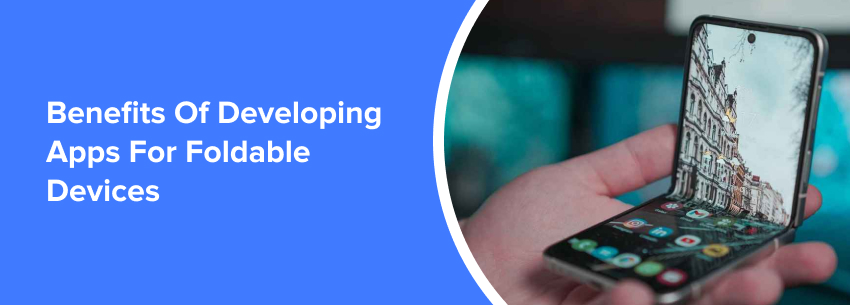
Developing an app for foldable devices can present challenges due to various complex issues related to the new technology. However, it is supported by several benefits. So let’s explore some changes and benefits that foldable device applications bring to their users and app development:
- Extra Screen Estate
Access to an enlarged screen space is one of the primary perks of developing applications for foldable devices. The applications developed for such devices revolve around providing users with extra screen space to execute their operations over the applications.
Once you successfully develop an application for a foldable device, you create a program that can expand beyond its limit. This way, your application can work in two states, one on the primary screen and one over the extended state when the device is open.
- Small Size Ratio
Similar to the expansion facility that adds to the functionality of different software applications, the small size ratio operation is also a pro of foldable device software. This unique expansion feature of the software works both ways, where it can expand and contract as per the usage of different users.
This way, the software over foldable devices gets multi functionality over one device. Users can expand and return their applications to the normal state based on their requirements.

- Access To More Features
Modern smartphones are limited by their fixed screen size, limiting users to run their applications fixed over a fixed screen resolution. Keeping the same in mind, modern developers must create mobile applications in mind of a fixed screen size.
However, thanks to the rise of foldable device technology, software developers now have the opportunity to pack their applications with more features. With their applications for foldable devices, creators can add more features to their software that will be unlocked as soon as the user transitions from their primary to an extended screen.
- Enhanced User Experience
The enhanced user experience is one of the most talked about perks of software for foldable devices. We say this because having a singular screen limits you to execute one operation at a time. Besides, even though users can switch between different applications, the user experience is generally lacking, along with the multi-functionality.
However, things are different for software over foldable devices. These applications are developed to offer an enhanced user experience to the device owners. For instance, if you’re a photographer or want to film things to share online, you’ll get better UX when using a foldable phone. Using software over foldable devices will allow you to use different camera angles to acquire even better pictures for your portfolio in closed or open modes.
- Access To New Markets
Foldable phones offer an additional benefit of providing extra internal space that can be utilized for hardware elements such as more powerful CPUs and larger (or dual) batteries. Larger screens require more power, and efforts are being made to meet these power requirements through ongoing advancements.
This way, software for foldable devices allows business owners to tap into a new market of users.
It focuses on users who desire more from their devices and enjoy performing multiple operations on their foldable smartphones.
Looking at such unique perks of developing applications for foldable devices, it’s evident that such gadgets are the future. Foldable devices bring along multiple functionalities simultaneously, allowing users to leverage them to the maximum.
Future Of Foldable Devices And Android App Development
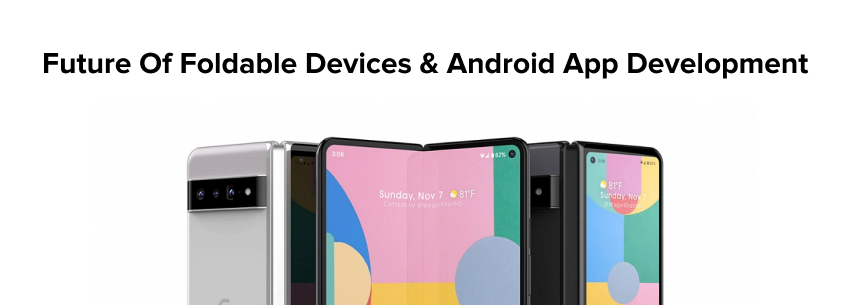
Foldable smartphone devices have introduced us to a new age of usage and functionality. These devices have uncovered a new age of functionality where applications can go beyond their traditional limits to introduce users to features that weren’t previously possible over smartphones with a specific screen resolution.
We can see new and more innovative designs for foldable devices in the future. Our active options are limited to seven screens that actively fold in different ratios to actively provide users with different UX.However, as we develop foldable device designs, we can discover new possibilities for foldable devices.
Users can come across new-age designs for their foldable devices. We could witness mobiles that are using new aspect ratios and folding innovatively. Moreover, some leaks around the latest developments suggest that devices could soon roll to adjust your wrist.
Besides, we could also witness new Android updates designed specifically for foldable devices. These updates could add new functionality to the existing list, attracting more users to the category.
What’s more? Customers who value a larger screen in a small package have expressed interest in foldable smartphones, which have demonstrated potential. However, foldable smartphones will gradually become more popular in India.
Active innovation and the inclusion of cutting-edge features actively enhance the appeal of foldable smartphones, despite two drawbacks that cannot be overlooked: weight and size. The battle to overtake unfoldable devices will be exciting as more OEMs enter the foldable smartphone market.
Conclusion
Foldable smartphones are the future! The budding technology offers users a new perspective on using their devices and opens a new venue for software developers to explore. However, as mentioned earlier, developing software apps for foldable devices isn’t as easy as the fun of running the applications.
Developing Android apps for foldable devices is filled with challenges, ranging from screen continuity to multi-window mode and app continuity. However, as foldable devices become more mainstream and there’s a fixed approach toward their development, we might come around to engaging software applications that could change the meaning of UX for these devices.
Moreover, it also implies that software developers for foldable smartphones will soon have the scope to innovate their offerings in the market. Looking at the concept, the stages of development, and the efforts that go behind it, it’s only a matter of time before foldable devices and applications will dominate the marketplace.
FAQs
As the name suggests, a foldable device is one whose screen can be folded. It uses a significantly different setting comprising a larger display, a larger battery, a hinge that binds the screens together, and most importantly a screen that can be tightly bent.
On the contrary, traditional mobile phones don’t have any such functionality. Since they only have one flat-screen display, there’s no option for users to fold their devices in this situation.
There are numerous benefits to developing apps for foldable devices. The most significant is the user experience that such applications impart. We have the expansion capability where the applications dynamically adjust to a new dimension and can again be minimized according to the screen ratio.
There are several challenges that developers face while developing apps for foldable devices. For one, they don’t have a fixed screen aspect ratio to work on. Moving ahead, keeping up with the screen continuity when users open up their devices becomes challenging. Interestingly, there’s more to these challenges, all explored in the sections above.
The foldable device uniquely impacts the UX design for the Android app. One of the most significant changes for users is how they adapt their applications to the larger screen. Many developers continue adding more features that can be unlocked on a bigger screen. This way, users love the experience they get over foldable smartphones.
Regarding traditional Android devices, developers don’t face the challenge of expanding their applications to a new aspect ratio. However, when developing their apps for foldable devices, they must use a flexible layout that can expand to any screen size and resolution per the device.
Optimizing an application for a foldable device is simple. However, it’s crucial to understand that as you prepare to design a project, optimizing apps for foldable devices and creating flexible user interfaces for DeX follow similar processes. It might be a good idea to do both at once to increase the value and future-proofs of your application.
– There are several best practices for developing Android apps for foldable devices, namely:
– Multi-Window Functionality
– Application Continuity
– Application Testing
– Testing Screen Ratios
Developers require numerous software to develop applications for foldable devices. The list includes RxJava support, Java, and Android support, among other features.
Related Articles
-
Four Golden Rules for Android Mobile Application Development
In this app freak world, the field of Android mobile application development is booming! Why? According to Statista, the number of android applications is 1.6 million, the highest as compared
-
Material You: The Radical New Design Language for Android
Back in 2014, Google introduced its Material design language in Android 5.0 Lollipop. This language has since evolved a great deal to make personalization better for Android users. However, in
-
Android Apps Killed Off By Google In The Year 2013
2013 has been one of the most important years for the Google as the company has introduced plenty of new products. Starting from various Android-based devices, Google has even introduced

